+ データを開く
データを開く
- 基本情報
基本情報
| 登録情報 | データベース: PDB / ID: 7oui | ||||||||||||||||||
|---|---|---|---|---|---|---|---|---|---|---|---|---|---|---|---|---|---|---|---|
| タイトル | Structure of C2S2M2-type Photosystem supercomplex from Arabidopsis thaliana (digitonin-extracted) | ||||||||||||||||||
 要素 要素 |
| ||||||||||||||||||
 キーワード キーワード | PHOTOSYNTHESIS / Oxidoreductase / Complex | ||||||||||||||||||
| 機能・相同性 |  機能・相同性情報 機能・相同性情報photoinhibition / photosynthesis, light harvesting in photosystem II / photosystem II antenna complex / PSII associated light-harvesting complex II / nonphotochemical quenching / plastid thylakoid membrane / chloroplast stromal thylakoid / thylakoid lumen / plastoglobule / response to high light intensity ...photoinhibition / photosynthesis, light harvesting in photosystem II / photosystem II antenna complex / PSII associated light-harvesting complex II / nonphotochemical quenching / plastid thylakoid membrane / chloroplast stromal thylakoid / thylakoid lumen / plastoglobule / response to high light intensity / thylakoid membrane / regulation of stomatal movement / chloroplast thylakoid / photosynthesis, light harvesting in photosystem I / vacuolar transport / thylakoid / chloroplast thylakoid lumen / apoplast / photosynthesis, light harvesting / photosystem II oxygen evolving complex / photosystem II assembly / response to abscisic acid / oxygen evolving activity / photosystem II stabilization / photosystem II reaction center / chloroplast envelope / photosystem II / oxidoreductase activity, acting on diphenols and related substances as donors, oxygen as acceptor / photosynthetic electron transport chain / photosystem I / photosystem II / response to herbicide / poly(U) RNA binding / chloroplast stroma / plastid / chlorophyll binding / photosynthetic electron transport in photosystem II / : / phosphate ion binding / chloroplast thylakoid membrane / photosynthesis, light reaction / response to light stimulus / photosynthesis / chloroplast / electron transfer activity / protein stabilization / iron ion binding / protein domain specific binding / mRNA binding / heme binding / endoplasmic reticulum / metal ion binding / nucleus / plasma membrane / cytosol 類似検索 - 分子機能 | ||||||||||||||||||
| 生物種 |  | ||||||||||||||||||
| 手法 | 電子顕微鏡法 / 単粒子再構成法 / クライオ電子顕微鏡法 / 解像度: 2.79 Å | ||||||||||||||||||
 データ登録者 データ登録者 | Graca, A.T. / Hall, M. / Persson, K. / Schroder, W.P. | ||||||||||||||||||
| 資金援助 |  スウェーデン, 2件 スウェーデン, 2件
| ||||||||||||||||||
 引用 引用 |  ジャーナル: Sci Rep / 年: 2021 ジャーナル: Sci Rep / 年: 2021タイトル: High-resolution model of Arabidopsis Photosystem II reveals the structural consequences of digitonin-extraction. 著者: André T Graça / Michael Hall / Karina Persson / Wolfgang P Schröder /  要旨: In higher plants, the photosynthetic process is performed and regulated by Photosystem II (PSII). Arabidopsis thaliana was the first higher plant with a fully sequenced genome, conferring it the ...In higher plants, the photosynthetic process is performed and regulated by Photosystem II (PSII). Arabidopsis thaliana was the first higher plant with a fully sequenced genome, conferring it the status of a model organism; nonetheless, a high-resolution structure of its Photosystem II is missing. We present the first Cryo-EM high-resolution structure of Arabidopsis PSII supercomplex with average resolution of 2.79 Å, an important model for future PSII studies. The digitonin extracted PSII complexes demonstrate the importance of: the LHG2630-lipid-headgroup in the trimerization of the light-harvesting complex II; the stabilization of the PsbJ subunit and the CP43-loop E by DGD520-lipid; the choice of detergent for the integrity of membrane protein complexes. Furthermore, our data shows at the anticipated MnCaO-site a single metal ion density as a reminiscent early stage of Photosystem II photoactivation. #1:  ジャーナル: Acta Crystallogr., Sect. D: Biol. Crystallogr. ジャーナル: Acta Crystallogr., Sect. D: Biol. Crystallogr.年: 2018 タイトル: Real-space refinement in PHENIX for cryo-EM and crystallography 著者: Afonine, P.V. / Poon, B.K. / Read, R.J. / Sobolev, O.V. / Terwilliger, T.C. / Urzhumtsev, A. / Adams, P.D. | ||||||||||||||||||
| 履歴 |
|
- 構造の表示
構造の表示
| ムービー |
 ムービービューア ムービービューア |
|---|---|
| 構造ビューア | 分子:  Molmil Molmil Jmol/JSmol Jmol/JSmol |
- ダウンロードとリンク
ダウンロードとリンク
- ダウンロード
ダウンロード
| PDBx/mmCIF形式 |  7oui.cif.gz 7oui.cif.gz | 1.8 MB | 表示 |  PDBx/mmCIF形式 PDBx/mmCIF形式 |
|---|---|---|---|---|
| PDB形式 |  pdb7oui.ent.gz pdb7oui.ent.gz | 1.6 MB | 表示 |  PDB形式 PDB形式 |
| PDBx/mmJSON形式 |  7oui.json.gz 7oui.json.gz | ツリー表示 |  PDBx/mmJSON形式 PDBx/mmJSON形式 | |
| その他 |  その他のダウンロード その他のダウンロード |
-検証レポート
| 文書・要旨 |  7oui_validation.pdf.gz 7oui_validation.pdf.gz | 22.8 MB | 表示 |  wwPDB検証レポート wwPDB検証レポート |
|---|---|---|---|---|
| 文書・詳細版 |  7oui_full_validation.pdf.gz 7oui_full_validation.pdf.gz | 24.5 MB | 表示 | |
| XML形式データ |  7oui_validation.xml.gz 7oui_validation.xml.gz | 534.7 KB | 表示 | |
| CIF形式データ |  7oui_validation.cif.gz 7oui_validation.cif.gz | 642.4 KB | 表示 | |
| アーカイブディレクトリ |  https://data.pdbj.org/pub/pdb/validation_reports/ou/7oui https://data.pdbj.org/pub/pdb/validation_reports/ou/7oui ftp://data.pdbj.org/pub/pdb/validation_reports/ou/7oui ftp://data.pdbj.org/pub/pdb/validation_reports/ou/7oui | HTTPS FTP |
-関連構造データ
- リンク
リンク
- 集合体
集合体
| 登録構造単位 | 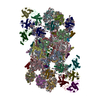
|
|---|---|
| 1 |
|
- 要素
要素
-Chlorophyll a-b binding protein, ... , 2種, 6分子 135748
| #1: タンパク質 | 分子量: 28193.934 Da / 分子数: 4 / 由来タイプ: 天然 由来: (天然)  Variant: Wild type / 参照: UniProt: Q39142 #3: タンパク質 | 分子量: 23198.287 Da / 分子数: 2 / 由来タイプ: 天然 由来: (天然)  Variant: Wild type / 参照: UniProt: Q9LMQ2 |
|---|
-Chlorophyll a-b binding protein ... , 4種, 12分子 26SsGNYgnyRr
| #2: タンパク質 | 分子量: 26452.990 Da / 分子数: 2 / 由来タイプ: 天然 由来: (天然)  Variant: Wild type / 参照: UniProt: Q9S7M0 #20: タンパク質 | 分子量: 25232.754 Da / 分子数: 2 / 由来タイプ: 天然 由来: (天然)  Variant: Wild type / 参照: UniProt: Q9XF89 #21: タンパク質 | 分子量: 24885.072 Da / 分子数: 6 / 由来タイプ: 天然 由来: (天然)  Variant: Wild type / 参照: UniProt: P04778 #22: タンパク質 | 分子量: 27302.855 Da / 分子数: 2 / 由来タイプ: 天然 由来: (天然)  Variant: Wild type / 参照: UniProt: Q07473 |
|---|
-Photosystem II ... , 13種, 26分子 AaBbCcDdHhIiKkLlMmTtWwZzUu
| #4: タンパク質 | 分子量: 38830.082 Da / 分子数: 2 / 由来タイプ: 天然 由来: (天然)  Variant: Wild type / 参照: UniProt: P83755, photosystem II #5: タンパク質 | 分子量: 56091.824 Da / 分子数: 2 / 由来タイプ: 天然 由来: (天然)  Variant: Wild type / 参照: UniProt: P56777 #6: タンパク質 | 分子量: 50086.324 Da / 分子数: 2 / 由来タイプ: 天然 由来: (天然)  Variant: Wild type / 参照: UniProt: P56778 #7: タンパク質 | 分子量: 39444.082 Da / 分子数: 2 / 由来タイプ: 天然 由来: (天然)  Variant: Wild type / 参照: UniProt: P56761, photosystem II #10: タンパク質 | 分子量: 7575.691 Da / 分子数: 2 / 由来タイプ: 天然 由来: (天然)  Variant: Wild type / 参照: UniProt: P56780 #11: タンパク質・ペプチド | 分子量: 4170.891 Da / 分子数: 2 / 由来タイプ: 天然 由来: (天然)  Variant: Wild type / 参照: UniProt: P62100 #12: タンパク質・ペプチド | 分子量: 4239.112 Da / 分子数: 2 / 由来タイプ: 天然 由来: (天然)  Variant: Wild type / 参照: UniProt: P56782 #13: タンパク質・ペプチド | 分子量: 4471.075 Da / 分子数: 2 / 由来タイプ: 天然 由来: (天然)  Variant: Wild type / 参照: UniProt: P60129 #14: タンパク質・ペプチド | 分子量: 3783.538 Da / 分子数: 2 / 由来タイプ: 天然 由来: (天然)  Variant: Wild type / 参照: UniProt: P62109 #16: タンパク質・ペプチド | 分子量: 3825.642 Da / 分子数: 2 / 由来タイプ: 天然 由来: (天然)  Variant: Wild type / 参照: UniProt: P61839 #17: タンパク質 | 分子量: 6036.749 Da / 分子数: 2 / 由来タイプ: 天然 由来: (天然)  Variant: Wild type / 参照: UniProt: Q39194 #19: タンパク質 | 分子量: 6569.768 Da / 分子数: 2 / 由来タイプ: 天然 由来: (天然)  Variant: Wild type / 参照: UniProt: P56790 #23: タンパク質・ペプチド | 分子量: 3178.810 Da / 分子数: 2 / 由来タイプ: 天然 由来: (天然)  Variant: Wild type / 参照: UniProt: Q39195 |
|---|
-Cytochrome b559 subunit ... , 2種, 4分子 EeFf
| #8: タンパク質 | 分子量: 9393.501 Da / 分子数: 2 / 由来タイプ: 天然 由来: (天然)  Variant: Wild type / 参照: UniProt: P56779 #9: タンパク質・ペプチド | 分子量: 4428.228 Da / 分子数: 2 / 由来タイプ: 天然 由来: (天然)  Variant: Wild type / 参照: UniProt: P62095 |
|---|
-タンパク質 / タンパク質・ペプチド / 糖 , 3種, 12分子 OoXx

| #15: タンパク質 | 分子量: 26594.639 Da / 分子数: 2 / 由来タイプ: 天然 由来: (天然)  Variant: Wild type / 参照: UniProt: P23321 #18: タンパク質・ペプチド | 分子量: 4186.916 Da / 分子数: 2 / 由来タイプ: 天然 由来: (天然)  Variant: Wild type / 参照: UniProt: A0A7G2E9B1 #35: 糖 | ChemComp-DGD / |
|---|
-非ポリマー , 18種, 505分子 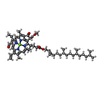






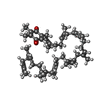
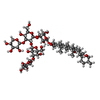
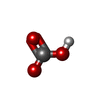




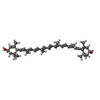
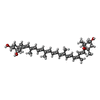
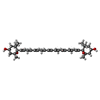


















| #24: 化合物 | ChemComp-CHL / #25: 化合物 | ChemComp-CLA / #26: 化合物 | ChemComp-LHG / #27: 化合物 | ChemComp-PHO / #28: 化合物 | ChemComp-BCR / #29: 化合物 | ChemComp-SQD / #30: 化合物 | ChemComp-LMG / #31: 化合物 | ChemComp-PL9 / #32: 化合物 | ChemComp-AJP / #33: 化合物 | #34: 化合物 | #36: 化合物 | ChemComp-CA / #37: 化合物 | #38: 化合物 | #39: 化合物 | ChemComp-LUT / ( #40: 化合物 | ChemComp-NEX / ( |
|---|
 ムービー
ムービー コントローラー
コントローラー



 UCSF Chimera
UCSF Chimera
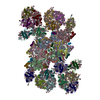

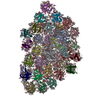
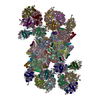

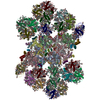
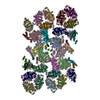
 PDBj
PDBj
























